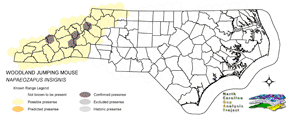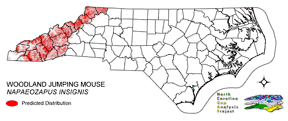
| Taxa: |
| Order: |
| Family: |
| Mammalia |
| Rodentia |
| Dipodidae |
| NatureServe Global Rank: |
| NatureServe State (NC) Rank: |
| G5 |
| S3 |
| Federal Status: |
| NC State Status: |
| --- |
| --- |


| Land Unit |
| US Fish & Wildlife Service |
| US Forest Service |
| US National Park Service |
| US Department of Defense |
| NC State Parks |
| NC University System |
| NC Wildlife Res. Com. |
| NC Forest Service |
| NC Div. of Coastal Mgmt. |
| Local Governments |
| Non-Governmental Org. |
| Other Public Lands |
| Private Lands |
| GAP Status 1-2 |
| All Protected Lands |
| Statewide |
| Hectares |
| 0.00 |
| 168,483.42 |
| 0.00 |
| 71,395.56 |
| 1,818.99 |
| 55.35 |
| 2,542.86 |
| 956.22 |
| 0.00 |
| 4,787.10 |
| 4,850.55 |
| 112.41 |
| 516,306.60 |
| 98,242.62 |
| 254,756.94 |
| 771,309.06 |
| Acres |
| 0.00 |
| 416,331.52 |
| 0.00 |
| 176,422.24 |
| 4,494.82 |
| 136.77 |
| 6,283.54 |
| 3,537.41 |
| 0.00 |
| 11,829.18 |
| 11,985.97 |
| 277.77 |
| 1,275,821.14 |
| 243,937.29 |
| 630,692.53 |
| 1,907,120.36 |
| % of Dist. on |
| Prot. Lands |
| 0.0 % |
| 66.1 % |
| 0.0 % |
| 28.0 % |
| 0.7 % |
| < 0.1 % |
| 1.0 % |
| 0.4 % |
| 0.0 % |
| 1.9 % |
| 1.9 % |
| < 0.1 % |
| 0.0 % |
| 38.6 % |
| ----- |
| ----- |
| % of Dist. on |
| All Lands |
| 0.0 % |
| 21.8 % |
| 0.0 % |
| 9.3 % |
| 0.2 % |
| < 0.1 % |
| 0.3 % |
| 0.1 % |
| 0.0 % |
| 0.6 % |
| 0.6 % |
| < 0.1 % |
| 66.9 % |
| 12.7 % |
| ----- |
| ----- |
|
The woodland jumping mouse is locally abundant in the southern Appalachian mountains, but is restricted to the mid and high elevations of the region (Lee et al. 1982). This mouse is a resident of cool, moist woodlands. However, ecotones with more open, herbaceous habitats in moist settings are used as well (Whitaker and Hamilton 1998). Open situations in conifer (primarily spruce-fir or hemlock) or mixed conifer and northern hardwood forest, rhododendron thickets, and rocky areas near water appear to be where the species reaches its highest population densities (Lee et al. 1982, Webster et al. 1985, Whitaker and Hamilton 1998). It also occurs in bog conditions (Webster et al. 1985). Nests are made in underground chambers, in piles of brush, or under fallen trees (Webster et al. 1985). NATURE SERVE GLOBAL HABITAT COMMENTS: Prefers deciduous and coniferous forests with herbaceous groundcover. Also occurs in brushlands. Nests in underground burrow (winter) or in log, stump, or under other cover. |
| Code | Name | Description | NC Natural Heritage Program Equivalent |
| 267 | Riverbank Shrublands | Riverside shrubs with temporarily flooded hydrologies. Found in the both the Mountains and Piedmont. Containing dominants such as smooth alder and a Carolina or black willows. | Sand and Mud Bar |
| 269 | Floodplain Wet Shrublands | Saturated shrublands of the Piedmont, includes buttonbush, swamp-loosestrife, decodon and alders. | Piedmont/mountain Semipermanent Impoundment |
| 230 | Piedmont Mesic Forest | American Beech - Red Oak - White Oak Forests. | Mesic Mixed Hardwood |
| 384 | Piedmont/Mountain Mixed Bottomland Hardwood Forests | Includes temporarily to seasonally forests dominated by hardwood species. Hardwoods include sweetgum, red maple, sycamore which co-occur in a mosaic of bottomland and levee positions. Includes alluvial hardwood forests in the mountains. Hemlock and white pine may occur as inclusions, but are generally mapped separately. | Piedmont/Mountain Alluvial Forest, Piedmont/Mountain Levee Forest |
| 383 | Piedmont Mixed Successional Forest | Generally loblolly mixed with successional hardwoods. Sweetgum, tulip poplar and red maple are common co-dominants in these successional forests. | No equivalent |
| 205 | Agricultural Pasture/Hay and Natural Herbaceous | Farm fields used for pasture grass or hay production, as well as old fields dominated by native and exotic grasses. | No equivalent |
| 517 | Hemlock Floodplain Forest | Alluvial forest with hemlock and/or white pine in mountains and western piedmont. Hydrology is generally temporarily to seasonally flooded. | Canada Hemlock Forest |
| 521 | Spruce/Fir Forest | High Elevation Frazer-Fir - Red Spruce, Red Spruce and Red-Spruce-Yellow Birch Forests. Tree densities included here include both woodland to forest density. Highly intermixed with Northern Hardwoods, Grassy Balds, and Shrub Balds. | Red Spruce--Fraser Fir Forest, Fraser Fir Forest |
| 522 | Northern Hardwoods | High Elevation forests including yellow birch, American beech, and yellow buckeye. Includes forests with Hemlock and Yellow Birch. | Northern Hardwoods Forest, Boulderfield Forest |
| 525 | Appalachian Oak Forest | A variety of oak forest types including Black, White, Scarlet Oaks in dry to mesic situations. Includes forests historically co-dominated by American Chestnut. | High Elevation Red Oak Forest, Montane White Oak Forest |
| 526 | Appalachian Cove Forest | Mixed Mesophytic forests of the mountains. Includes tuliptree, basswood, yellow buckeye and surgar maple. This class is mapped to include cove forests dominated or co-dominated by hemlock. | Rich Cove Forest, Acidic Cove Forest |
| 527 | Appalachian Hemlock | Upland hemlock forests of the moutains region. Vary from side slopes to steep slope positions. | Canada Hemlock Forest |
| 533 | Appalachian Swamp Forest | Evergreen and deciduous forests with saturated hydrologies. This class may contain a variety of trees species, including hemlock - red maple, pitch pine, and white pine forests. | Swamp Forest-Bog Complex, Southern Appalachian Bog, Southern Appalachian Fen |
| 534 | Appalachian Wet Shrubland/ Herbaceous | Saturated shrubs and herbaceous vegetation. Often mapped as an inclusion in Appalachian Swamp Forest. | Southern Appalachian Bog, Southern Appalachian Fen |
|
Blair, W.F. 1941. Same data on home ranges and general life history of the short-tailed shrew, redbacked mouse and wood-land jumping mouse in northern Michigan. Am. Midl. Nat. 25(3):681-685.
Ovaska, K., and T. B. Herman. 1988. Life history characteristics and movements of the woodland jumping mouse, NAPAEOZAPUS INSIGNIS, in Nova Scotia. Can. J. Zool. 66:1752-1762. Townsend, M. T. 1935. Studies on some of the small mammalsof central New York. Roosevelt Wildl. Ann. 4. 120 pp. Jones, J. K., Jr., et al. 1992. Revised checklist of North American mammals north of Mexico, 1991. Occas. Pap. Mus., Texas Tech Univ. (146):1-23. Wilson, D. E., and D. M. Reeder (editors). 1993. Mammal Species of the World:a Taxonomic and Geographic Reference. Second Edition. Smithsonian Institution Press, Washington, DC. xviii + 1206 pp. Whitaker, J.O. Jr. and W.J. Hamilton, Jr. 1998. Mammals of the eastern United States. Cornell Univ. Press, Ithaca, New York. 583 pp. Preble, E. A. 1899. Revision of the jumping mice of the genus Zapus. North American Fauna 15:1-43. Lee, D. S., L. B. Funderburg Jr., and M. K. Clark. 1982. A distributional survey of North Carolina mammals. Occasional Papers of the North Carolina Biological Survey, No. 1982-10. North Carolina State. Mus. Nat. Hist., Raleigh, North Carolina. 72 pp. Brower, J.E. and T.J. Cade. 1966. Ecology and physiology of Mapaeozapus insignis (Miller) and other woodland mice. Ecology, 47(1):46-63. Whitaker, J.O., and R. E. Wrigley. 1972. ZAPUS HUDSONIUS. Am. Soc. Mamm., Mammalian Species No. 11. 7 pp. Wrigley, R. E. 1972. Systematics and biology of the woodland jumping mouse Napaeozapus insignis. Illinois Biol.Monogr. 47. Univ. Chicago Press, Urbana, IL. 117 pp. Banfield, A.W.F. 1974. The mammals of Canada. University of Toronto Press, Toronto. Godin, A.J. 1977. Wild Mammals of New England. Johns Hopkins University Press, Baltimore. 304 pp. Hamilton, William J., Jr., and John O. Whitaker, Jr. 1979. Mammals of the eastern United States. Cornell Univ. Press, Ithaca, New York. 346 pp. Hall, E. R. 1981. The Mammals of North America. Second edition. 2 Volumes. John Wiley and Sons, New York, New York. Baker, Rollin H. 1983. Michigan mammals. Michigan State University Press. 642 pp. Webster, W. D., J. F. Parnell and W. C. Biggs Jr. 1985. Mammals of the Carolinas, Virginia, and Maryland. The University of North Carolina Press, Chapel Hill, NC. |
For more information please contact them at:
NC-GAP Analysis Project
Dept. of Zoology, NCSU
Campus Box 7617
Raleigh, NC 27695-7617
(919) 513-2853
www.basic.ncsu.edu/ncgap